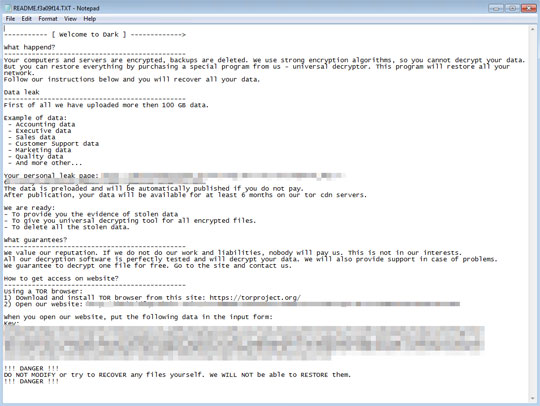Ransom.Win32.DARKSIDE.YXAH-THA
Windows


Threat Type: Ransomware
Destructiveness: No
Encrypted: Yes
In the wild: Yes
OVERVIEW
This Ransomware arrives on a system as a file dropped by other malware or as a file downloaded unknowingly by users when visiting malicious sites.
It drops files as ransom note. It avoids encrypting files with the following file extensions.
TECHNICAL DETAILS
Arrival Details
This Ransomware arrives on a system as a file dropped by other malware or as a file downloaded unknowingly by users when visiting malicious sites.
Installation
This Ransomware drops the following files:
- {Malware Directory}\LOG.{Appended Extension}.TXT ? Log File
Process Termination
This Ransomware terminates the following services if found on the affected system:
- vss
- sql
- svc$
- memtas
- mepocs
- sophos
- veeam
- backup
It terminates the following processes if found running in the affected system's memory:
- sql
- oracle
- ocssd
- dbsnmp
- synctime
- agntsvc
- isqlplussvc
- xfssvccon
- mydesktopservice
- ocautoupds
- encsvc
- firefox
- tbirdconfig
- mydesktopqos
- ocomm
- dbeng50
- sqbcoreservice
- excel
- infopath
- msaccess
- mspub
- onenote
- outlook
- powerpnt
- steam
- thebat
- thunderbird
- visio
- winword
- wordpad
- notepad
Other Details
This Ransomware does the following:
- It checks if its privilege level is on SYSTEM level. If it is, it will impersonate the user that ran the first explorer.exe it has found.
- It searches for files to encrypt in fixed drives, removable drives, and network resources.
- It is capable of deleting shadow copies.
- It is capable of emptying Recycle Bin.
Ransomware Routine
This Ransomware avoids encrypting files with the following strings in their file name:
- autorun.inf
- boot.ini
- bootfont.bin
- bootsect.bak
- desktop.ini
- iconcache.db
- ntldr
- ntuser.dat
- ntuser.dat.log
- ntuser.ini
- thumbs.db
- LOG.{Appended Extension}.TXT
- README.{Appended extension}.TXT
It avoids encrypting files with the following strings in their file path:
- $recycle bin
- config.msi
- $windows.~bt
- $windows.~ws
- windows
- appdata
- application data
- boot
- mozilla
- program files
- program files (x86)
- program data
- system volume information
- tor browser
- windows.old
- intel
- msocache
- perflogs
- x64dbg
- public
- all users
- default
It appends the following extension to the file name of the encrypted files:
- .{Generated Characters from Mac Address}
It drops the following file(s) as ransom note:
- {Encrypted Directory}\README.{Appended Extension}.TXT

It avoids encrypting files with the following file extensions:
- .386
- .adv
- .ani
- .bat
- .cab
- .cmd
- .com
- .cpl
- .cur
- .deskthemepack
- .diagcab
- .diagcfg
- .diagpkg
- .dll
- .drv
- .exe
- .hlp
- .icl
- .icns
- .ico
- .ics
- .idx
- .ldf
- .lnk
- .mod
- .mpa
- .msc
- .msp
- .msstyles
- .msunls
- .nomedia
- .ocx
- .prf
- .ps1
- .rom
- .rtp
- .scr
- .sys
- .theme
- .themepack
- .wpx
- .lock
- .key
- .hta
- .msi
- .pdb
- .{Appended Extension}
SOLUTION
Step 1
Trend Micro Predictive Machine Learning detects and blocks malware at the first sign of its existence, before it executes on your system. When enabled, your Trend Micro product detects this malware under the following machine learning name:
- Troj.Win32.TRX.XXPE50FFF036
Step 2
Before doing any scans, Windows 7, Windows 8, Windows 8.1, and Windows 10 users must disable System Restore to allow full scanning of their computers.
Step 3
Note that not all files, folders, and registry keys and entries are installed on your computer during this malware's/spyware's/grayware's execution. This may be due to incomplete installation or other operating system conditions. If you do not find the same files/folders/registry information, please proceed to the next step.
Step 4
Identify and terminate files detected as Ransom.Win32.DARKSIDE.YXAH-THA
- Windows Task Manager may not display all running processes. In this case, please use a third-party process viewer, preferably Process Explorer, to terminate the malware/grayware/spyware file. You may download the said tool here.
- If the detected file is displayed in either Windows Task Manager or Process Explorer but you cannot delete it, restart your computer in safe mode. To do this, refer to this link for the complete steps.
- If the detected file is not displayed in either Windows Task Manager or Process Explorer, continue doing the next steps.
Step 5
Search and delete these files
- LOG.{Appended Extension}.TXT
- README.{Appended extension}.TXT
Step 6
Restore encrypted files from backup.
Did this description help? Tell us how we did.


